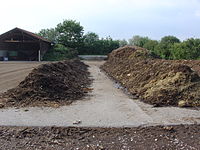
Photo from wikipedia
Economic production of lignocellulose degrading enzymes for biofuel industries is of considerable interest to the biotechnology community. While these enzymes are widely distributed in fungi, their industrial production from other… Click to show full abstract
Economic production of lignocellulose degrading enzymes for biofuel industries is of considerable interest to the biotechnology community. While these enzymes are widely distributed in fungi, their industrial production from other sources, particularly by thermophilic anaerobic bacteria (growth Topt ≥ 60 °C), is an emerging field. Thermophilic anaerobic bacteria produce a large number of lignocellulolytic enzymes having unique structural features and employ different schemes for biomass degradation, which can be classified into four systems namely; 'free enzyme system', 'cell anchored enzymes', 'complex cellulosome system', and 'multifunctional multimodular enzyme system'. Such enzymes exhibit high specific activity and have a natural ability to withstand harsh bioprocessing conditions. However, achieving a higher production of these thermostable enzymes at current bioprocessing targets is challenging. In this review, the research opportunities for these distinct enzyme systems in the biofuel industry and the associated technological challenges are discussed. The current status of research findings is highlighted along with a detailed description of the categorization of the different enzyme production schemes. It is anticipated that high temperature-based bioprocessing will become an integral part of sustainable bioenergy production in the near future.
Journal Title: International journal of biological macromolecules
Year Published: 2020
Link to full text (if available)
Share on Social Media: Sign Up to like & get
recommendations!